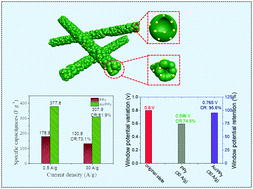A flexible and capsular polypyrrole nanotubular film-based pseudo-capacitive electrode with enhanced capacitive properties enabled by Au nanoparticle doping†
Abstract
Conducting polymer (CP)-based pseudocapacitive electrodes with good capacitance/rate capabilities and high potential window retention (namely, a neglectable IR drop) under high current density are of great interest due to their practical applications in fabricating instantaneous and high-power energy devices. However, they remain a challenge to realize. Herein, we report an alternative route for enhancing the capacitive properties of polypyrrole nanofibrous membrane (PPy NM)-based electrodes without adding any capacitive materials. The new strategy involves doping with Au nanoparticles via electrospinning followed by in situ polymerization. Compared with a pristine PPy NM, the specific capacitance of the Au/PPy NM was enhanced from 193.7 to 455.3 F g−1 at a scan rate of 5 mV s−1. Additionally, the rate capabilities were enhanced over broad ranges of current density (0.5–30 A g−1) and scan rate (5–1000 mV s−1). Interestingly, the potential window retention was greatly enhanced from 74.5% (PPy NM) to 95.6% (Au/PPy NM) over a wide range of current densities (0.5–30 A g−1). The Au/PPy NM also exhibited good cycling stability (>85% over 10 000 charge–discharge cycles under a current density of 30 A g−1).



 Please wait while we load your content...
Please wait while we load your content...